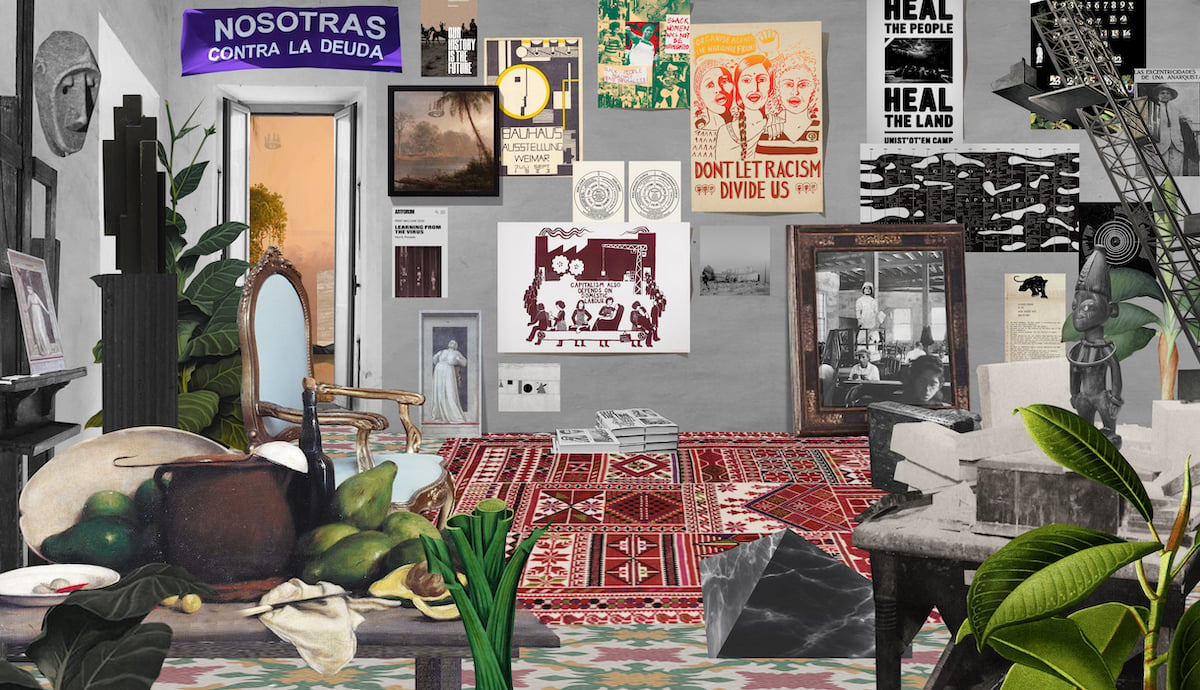
This month ThinkLab is pleased to welcome guest authors Cruz Garcia and Nathalie Frankowski of WAI Think Tank as they invite us to (re)consider the role of architecture and design in the construction of a better future.
The world will never be the same, and we have the opportunity to make that a good thing.
As 2020 showed us, all that is solid melts into air. Air moved from the background of our lives to the center of our most urgent challenges. Not only the air that carries dangerous viruses, but also the air that was forcefully removed that motivated the collective chants of “I can’t breathe,” denouncing the legacy of anti-Black violence — both have made us reconsider how to live together.
Like air, architecture has also made a recent appearance in the collective imagination. It doesn’t matter how atomized our lives have been made by the forces of capitalism — we are all connected through a maze of architectural spaces of varying scales. Escaping has become less of a possibility. As buildings, cities, and countries have shut down, the entanglement of our built and destroyed environment with the challenges in our society — of race, class, gender, mobility, care, dwelling, and ecology — have been rendered visible perhaps like no other time before.
From our disciplinary silos, we have witnessed, with both impotence and hope, the limitations and possibilities of our infrastructures and buildings. We have observed how crucial architecture and its effects have been on the environment and our lives. As we start 2022, we have the opportunity to rethink concepts we have taken for granted, and dream about the possibility of better futures for all.
The following are five points to (re)consider as we think about architecture’s role in the construction of the future:
Architecture is not just about buildings.
The global COVID-19 pandemic and the Black Lives Matter protests have shown that architecture across scales — from the home to the hospital, supermarket, school, police station, and prison — determines our freedom of mobility and access to care and has immense effects on our emotional, psychological, and physical well-being. It is not enough to think about architecture as buildings designed and commissioned by a few. Not when we realize that a system of spaces of varying scales have so much weight on our sense of control, safety, oppression, and freedom.
As a society, we must reconsider and re-engage with the role, effects, limitations, and possibilities of architecture. As a design discipline, we need to deprofessionalize and be much more generous and expansive when thinking about the effects of the built and destroyed environment.
Home is...where work is.
The pandemic has forced many of those with basic access to a home to retreat and work there (as long as they haven’t been classified as essential workers). The result: We have learned about the limitations of our living spaces, and how difficult it is to separate a space for labor from a space to “live life.” As work keeps multiplying at home, where unrewarded labor was already taking place, we must reconsider what the design and the economic politics of the domestic sphere are.
Domestic work — as Silvia Federici argues in “Wages for Housework” — is unwaged labor that asymmetrically exploits women and relies on the perpetuation of gendered roles. A 2020 study reported by the New York Times revealed that if women had earned minimum wage in 2019 for the “unpaid work they do around the house and caring for relatives,” they would have made $1.5 trillion in the U.S. — and a total of $10.9 trillion globally.
There’s no work outside of the home without the labor that takes place within it. There’s no hope for a better, more inclusive, radical future, without a revolution of domesticity — one that accounts not only for the design of spaces to work and live life, but that provides wages for the gendered and racialized labor that has already gone unrewarded.
To be truly inclusive, we will have to rethink disciplinary boundaries.
The model of the Bauhaus imagined a modern division of disciplines by gender: Women were not allowed to study architecture and were forced to study disciplines related to domesticity and interior design. This model has proven ineffectual to deal with the challenges of our times. As spaces lose their strict definition, work and life become ever more blurred, and global ecological and social challenges become irreversibly entangled, designers of the future will have to be able to navigate different scales — all while addressing a plethora of social and ecological complications.

For design disciplines to become increasingly diverse, disciplinary boundaries will have to dissipate. They will need to give way to the radical decentralization of knowledge and an acknowledgment that designers will no longer be telling people how to live from their position of absolute expertise and power. Instead, designers will be devising ways to facilitate ways of worldmaking that are devised by the people.
Rather than designers going into communities, communities will produce their designers. Aesthetic sensibility will have to respond to social and ecological demands. The ideological walls that separate disciplines will become as obsolete as the walls that divide communities.
There's no immunity without community.
While philosopher Paul B. Preciado affirms that if, historically, immunity was a privilege that released someone from the obligations shared by all, to avoid addressing the needs of the collective today means to compromise the possibility of building immunity at the scale of community.
As we start to understand community as encompassing the entire planet — since separation is no longer possible in an intrinsically imbricated world — we must rethink the design of spaces to live life. And we must rethink practices of solidarity that not only affect us personally, but also a growing community that, however far, is affected by us and by the decisions we take.
To think about community planning and design amid a global pandemic and social unrest is to think about planetary well-being and global networks of solidarity. As we strive for a world in ecological and social balance, designers of the future will have to account for relationability, not only among humans, but also among the living and the non-living.
This is a great time to be creative.
While the global pandemic and the abolitionist demands of Black Lives Matter have revealed some of the deepest fissures in our societies, we have hope for younger generations that are more informed, socially aware, politically conscious, connected, and optimistic than ever before.
We believe that socially conscious designers living in unprecedented times have the opportunity (as they have already shown) to find ways to use their skills, creativity, sensibilities, empathy, solidarity, and consciousness for a more just future: to fight further alienation, listen to the unheard, display class solidarity, denounce and address systemic racial and gender oppression, and think about the possibility of making better worlds together.
As extraordinary challenges collide, critical forms of creativity become fundamental for worldmaking. Other worlds are not only possible, but necessary.
 WAI Architecture Think Tank is a planetary studio practicing by questioning the political, historical, and material legacy and imperatives of architecture and urbanism. Founded in Brussels during the financial crisis of 2008 by Puerto Rican architect, artist, curator, educator, author, and theorist Cruz Garcia and French architect, artist, curator, educator, author, and poet Nathalie Frankowski, WAI is one of their several platforms of public engagement that include Beijing-based anti-profit art space Intelligentsia Gallery, and the free and alternative education platform and trade school Loudreaders. Garcia and Frankowski are Associate Professors of Architecture at Iowa State University.
WAI Architecture Think Tank is a planetary studio practicing by questioning the political, historical, and material legacy and imperatives of architecture and urbanism. Founded in Brussels during the financial crisis of 2008 by Puerto Rican architect, artist, curator, educator, author, and theorist Cruz Garcia and French architect, artist, curator, educator, author, and poet Nathalie Frankowski, WAI is one of their several platforms of public engagement that include Beijing-based anti-profit art space Intelligentsia Gallery, and the free and alternative education platform and trade school Loudreaders. Garcia and Frankowski are Associate Professors of Architecture at Iowa State University.


